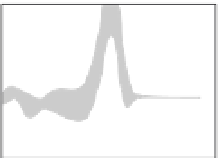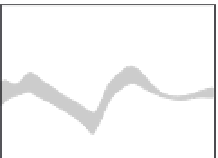Biomedical Engineering Reference
In-Depth Information
Hip
Knee
Ankle
Flexion
75
30
45
Joint
Rotation
(degrees)
10
45
25
5
15
−
10
Extension
−
15
−
30
−
15
2
Extensor
Joint
Moment
(N-m/kg)
1
0
Flexor
−
1
3
2
1
0
−
1
−
Generation
Joint
Power
(Watts/kg)
Absorption
2
0 25 50 75 100
% Gait Cycle
0 25 50 75 100
% Gait Cycle
0 25 50 75 100
% Gait Cycle
FIGURE 4.33
Sagittal joint kinetic data for the same cerebral palsy patient of Figure 4.31. Joint rotation, joint
moment, and joint power are plotted as functions of percent of gait cycle for the hip, knee, and ankle. Dark
and light solid curves denote right and left sides, respectively. Bands indicate
þ
/
one standard deviation of
the normal population.
knee extensor (also observed during clinical examination), impedes knee flexion. Moreover,
the inappropriate activity of the ankle plantar flexor, primarily the gastrocnemius muscle,
in late swing suggests that it is overpowering the pretibial muscles, primarily the anterior
tibialis muscle, resulting in plantar flexion of the ankle or “foot drop.”
The sagittal joint kinetics for this patient (Figure 4.33) demonstrate asymmetrical involve-
ment of the right and left sides. Of special note is that her right knee and hip are compen-
sating for some of the dysfunction observed on the left side. Specifically, the progressively
increasing right knee flexion beginning at midstance (first row, center) and continuing into
swing aids her contralateral limb in forward advancement during swing—that is, her pelvis
can rock posteriorly along with a flexing hip to advance the thigh. One potentially adverse
consequence of this adaptation is the elevated knee extensor moment in late stance that
increases patella-femoral loading with indeterminate effects over time. The asymmetrical
power production at the hip also illustrates clearly that the right lower extremity, in partic-
ular the muscles that cross the hip, provides the propulsion for gait with significant power
generation early in stance to pull the body forward and elevate its center of gravity. More-
over, the impressive hip power generation, both with respect to magnitude and timing, at
toe-off accelerates the stance limb into swing and facilitates knee flexion in spite of the ele-
vated knee extensor moment magnitude. This is important to appreciate given the bilateral
spastic response of the plantar flexor muscles, as evidenced by the premature ankle power





























































































































